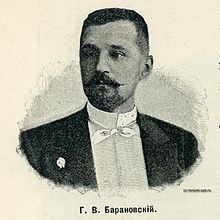Gavriil Baranovsky
| Gavriil Vasilyevich Baranovsky | |
|---|---|
 |
|
| Born | 6 April [O.S. 25 March] 1860 Odessa |
| Died | June 20, 1920 (aged 60) Kellomäki, Finland |
| Nationality | Russia |
| Occupation | Architect |
| Buildings | Elisseeff Buildings, Saint Petersburg |
| Projects | First town plan for Murmansk, 1917 |
Gavriil Vasilyevich Baranovsky (Russian: Гавриил Васильевич Барановский, also spelled as Baranovskii, 6 April [O.S. 25 March] 1860 - 28 June 1920) was a Russian architect, civil engineer, art historian and publisher, who worked primarily in Saint Petersburg for the Elisseeff family, but also practiced in Moscow and produced the first town plan for Murmansk (then Romanov-na-Murmane).
He was born in Odessa to attorney Vasili Ivanovitš Baranovsky and his wife Rosalia Malinovska Gavriil Baranovsky. Baranovsky trained at Saint Petersburg Institute of Civil Engineers (1881–1886), graduating with an honorary silver medal. He began his architectural career as an assistant to Paul Susor (Pavel Susor) between 1883 and 1885. His first commission was a state-financed Main Palace Chancellery (Главная дворцовая канцелярия); in 1885-1888, Baranovsky worked on numerous apartment buildings in Saint Petersburg. After 1888 he became staff architect for the Baltic Shipyards.
Baranovsky was married to a daughter of Grigory Elisseeff of the Elisseeff (Yeliseyev, Elisseieff) merchant family based in Saint Petersburg, owner of a lot of local real estate. Grigory Elisseeff's apartment building (1889–1890) became Baranovsky's first independent commission as a lead architect. Later, Baranovsky completed various country homes for the Elisseeff family and, most visible of his buildings, an eclectic Elisseeff Emporium on Nevsky Prospect (1900–1903) and its Moscow counterpart, the Elisseeff Store on Tverskaya Street (1898–1901, with Marian Peretyatkovich). In 1898 Baranovsky was appointed construction manager for all Elisseeff businesses.
Baranovsky's style varied through different shades of eclectics, eventually focusing on Art Nouveau.
...
Wikipedia
